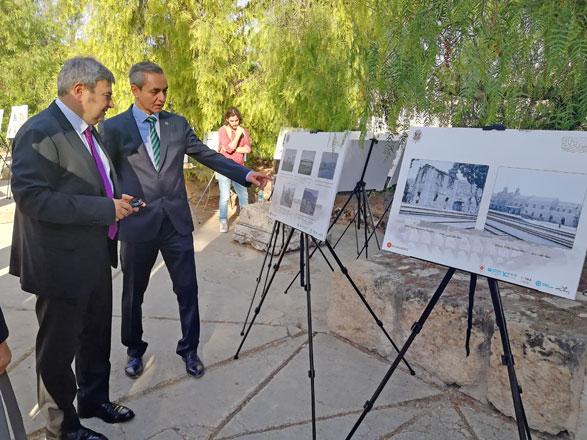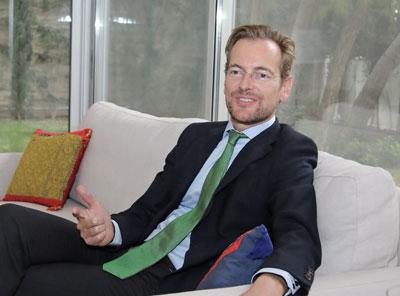You are here
Random photo leads to exhibition celebrating Heritage days in Jordan
By Muath Freij - Oct 11,2018 - Last updated at Oct 11,2018

This photo, taken by Lucian Kupfer, shows him and an engineer on the way to Maan city (Photo courtesy of collection of Cornilia Koenig, Regensburg)
AMMAN — A single photo of an abandoned railway in the middle of the Jordanian desert prompted the Belgium embassy in Amman to team up with other parties to bring together rare photographs of the Hijaz Railway as part of a one-month exhibition.
The exhibition follows the railway through Jordan, from concept to construction and conflict, with rare photos from several Jordanian, European and Turkish archives and collections, according to a statement by the Belgium embassy, which noted that the event is organised as part of the European year of cultural heritage and the Heritage Days in Jordan.
In a recent interview with The Jordan Times, Belgian Ambassador in Amman Hendrik Van de Velde said: “Our cultural attaché [Jessica Batshone] came to my office saying that for the European year of cultural heritage, Belgium could do something. I then remembered that a priest, who is an archeologist in Jerusalem, had sent us a beautiful photo two years ago of a Belgian railway in the middle of the desert where he was doing excavations."
The word Cockerill, a major Belgian steel company at the beginning of the 20th century, was emblazoned on the tracks, the diplomat recounted, saying this triggered his curiosity and later contributed to the introduction of the exhibition.
"The idea is to show the continuous links, culturally and at all levels, between the countries of Europe and this region throughout history," he said.
Andrea Matteo Fontana, EU ambassador to Jordan, echoed Van de Velde’s sentiment.
“When we launched the Jordan culture days last week, that was one of the things we emphasised is this continuous exchange between Europe, the Arab world and Jordan in particular,” he told The Jordan Times, noting that the Hijaz railway was built by the Ottomans, but many of the engineers were European.
“There was the head engineer who was German and there is an important German effort behind the exhibition with our Belgian friends. Then you had Belgian, Greek and Italian engineers. This was a wonderful idea to shed some light on this project which was a European project in the Arab world, and to show how continuous our links are between Europe and the Arab world,” Fontana added.
Raja Garghour, director of the Royal Heritage Directorate, said that the railway played a very interesting and important role in shaping the look and development of Jordanian towns, especially Maan, and how the railway became important in winning over the Ottomans.
“When we look at Aqaba Fort where the exhibition is being held, it has a fantastic history and in the end it played a pivotal role in changing the course of the great Arab Revolt, so really the project encompasses the early history of Jordan very well,” Gargour said, calling the fort "a masterpiece" very rarely seen by Aqaba’s visitors.
“Aqaba fort played an important role in the history of the Hijaz railway and in the history of the creation of Jordan, we thought Aqaba would be a very interesting place to host it,” she added.
“Economy is the number one worry in the minds of Jordanians today. I think Aqaba is a very attractive place to hold this exhibition because tourism in Aqaba is developing, you have several projects with a lot of investments, and I think there are many more sites that are less known that could be developed with local communities in mind which can really help them to benefit from tourism. This could create jobs locally and we are looking into this,” Fontana said.
For the Belgian ambassador, photography is an important element of the heritage days in Jordan. “How do you exemplify something better than through photos? We did not have videos at the time, but the liveliest things we have are pictures. It has not been that easy to find the pictures, it was a long search and Jessica did a quite bit of research,” he said stressing how much change of the cities is reflected in the photos.
The exhibition was organised in cooperation with the Royal Heritage Directorate-Royal Hashemite Court, the embassy of Belgium in Jordan, the Goethe-Institute Jordan, in collaboration with ASEZA, the École Biblique et Archéologique Française de Jérusalem and the Department of Antiquities, with the support of the European Union and EUNIC Jordan, according to the statement.
Related Articles
AMMAN — HRH Princess Rym on Tuesday attended the closing ceremony of the European Union National Institutes for Culture (EUNIC) Jordan’s sec
AMMAN — Turkish Ambassador to Jordan Murat Karagöz on Monday opened an exhibition focusing on the Hijaz Railway at Darat Al Funun in Amman.T
AMMAN — The potential for increased cooperation between Jordan and Belgium, which are key partners in the war on terror, is large, according



















